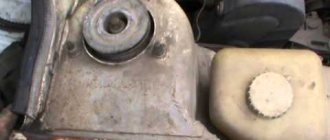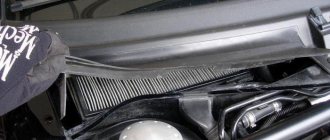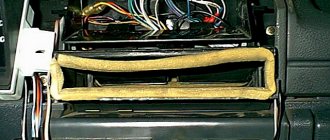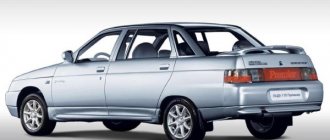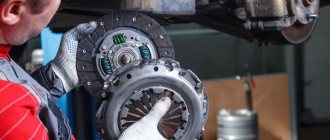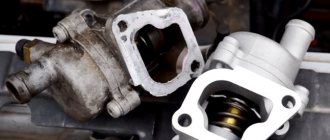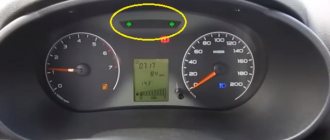Hi all! Guys, tell me, at idle there is excessive vibration in the cabin, and in my opinion the tachometer needle should stay higher, you increase the speed a little, everything is fine. I understand that the engine is shaking, but why (8 cl 87 hp). Who treated this problem how?
Which support bearings are better to take?
by Adminrive · Published 07/01/2015
Hello everyone, the engine is constantly adjusting when it’s cold, what could it be?
by Adminrive · Published 04/19/2016
Not much changed
by Adminrive · Published 03/27/2015
24 comments
- Comments 14
- Pingbacks 0
That's how it should be. I have the same arrow. I think everyone is like that. and no vibration.
Maybe you don't have enough oil or the oil is bad. Maybe because of poor quality gasoline, try changing the gas station and fill it with 95
Complaint: Lack of engine coolant temperature gauge
New software is currently being tested that allows the coolant temperature indicator function to be added to the BC. This indicator can be displayed on the screen using the button on the steering column switch. During the upgrade, the instrument cluster software will be updated. If the client wants to purchase a new BC function on an already purchased car, the instrument cluster will need to be replaced. It is planned that LADA Granta and LADA Kalina cars with a coolant temperature indicator will go on sale in early summer.
It is worth noting that the new LADA Kalina and LADA Granta use an increased efficiency engine cooling system. Therefore, when the engine is warm, the temperature may not rise above 77 degrees. This is determined by the lower limit of the thermostat valve opening.
Complaint: Poor quality ignition coils
A decision was made to change the supplier: from April 2014, instead of f. SOATE coils are used f. Dynatec.
Complaint: Incorrect operation of multimedia, lack of navigator.
As was said during the last meeting, AVTOVAZ is already using improved firmware (No. 38) for the standard MMC. Currently, the technology for reflashing MMC is being developed at LADA dealers: an information letter from AVTOVAZ has already been sent out.
As for the navigator, testing of this system continues today. It is planned to introduce it on LADA Granta at the end of 2014, on LADA Kalina - in the first half of 2015. As already noted, the main navigator screen will be located on the standard multimedia display. And on the instrument cluster there will be a direction indicator.
Complaint: Insufficient sound quality from standard speakers.
Noted.
Complaint: In screensaver mode, multimedia starts to respond only from the second key press - this is an unnecessary action.
Noted.
Complaint: Corrosion of outer door panels under vibration insulation.
The root cause is that the vibration-isolating pad extends onto the stamping line, some cavities are formed, and as a result of moisture condensation in these cavities during operation, corrosion can form. In March 2014, a vibration-absorbing gasket was introduced on the front and rear doors, which does not interfere with the stamping. This eliminates the occurrence of cavities. The next solution is a magnetic gasket, which will be installed after cataphoresis treatment of the body. During the installation process, it sticks to the cataphoresis coating of the body, then, passing through the mastic drying chamber, it melts. This is a modern, technological solution.
Complaint: Corrosion of chips on the roof edge.
An adjustment was made to the robot program in the paint shop in January 2014: in the area of the windshield edge, the thickness of the polyester primer coating (on which the enamel is applied) was increased by 10 microns, and the thickness of the varnish was increased by approximately 10 microns. If we consider that the facial zone is 90-130 microns, then an additional 20 microns is a significant amount. This increases resistance to chipping and reduces the risk of damage to the paintwork when installing glass.
As for the general resistance of the paintwork to chipping, we note that the polyester primer introduced on the LADA Kalina has quite high resistance. For comparison, photos of the paintwork after testing are provided. Chip resistance test in laboratory conditions: “classic”, LADA 110 and LADA Kalina. The photo shows that the LADA Kalina paintwork is much more resistant to chips. But it is impossible to completely protect it from chips. It is no coincidence that the instruction manual states the need to monitor the body and promptly correct damage to the paintwork.
Triple
This popular “term” means that one of the cylinders is not working, that is, out of four (the most common number of cylinders on passenger cars), only three are functioning - hence the word. This can be understood by several symptoms:
- the engine starts hesitantly;
- after warming up, the vibration does not disappear;
- the car pulls poorly and jerks;
- increased fuel consumption.
The situation should be corrected as soon as possible. When one cylinder is not working, the load on the others increases sharply. In this case, unburned fuel washes away the lubricant from the walls, thereby wearing out the cylinder bore. There is also a gradual coking of the channels, which sooner or later leads to premature engine overhaul. The main reasons for tripling:
- defect, broken spark plug;
- malfunction of high-voltage wires;
- breakdown of the ignition distributor (distributor), module (on front-wheel drive cars);
- severe wear of one of the elements of the CPG.
It is very easy to check that the cylinders are working properly. To do this, start the engine, put on a rubber glove and remove the high-voltage wires from the spark plugs one by one. If in one of the cases the nature of the engine operation has not changed, then you have found the “culprit” cylinder.
Lada Granta suspension diagnostics
To identify and eliminate the cause of the rattling, I decided to inspect the entire suspension of the Lada Grant for the presence of play and “tired” elements (bushings, rubber bands, etc.), since I thought that the problem lay somewhere there. So, let's begin.
Checking the front struts
The first thing I did was check the front struts. While rocking the car from side to side, I simultaneously kept one hand on one of the racks. If the knocks were coming from the front shock absorbers, I would have felt them. However, there were no knocks.
Photo 2: Is there a knocking noise in the front struts of the Lada Granta?
I also looked under the front wheel arches to make a visual inspection of the front shock absorbers - I didn’t see anything special there, the struts were dry.
Photo 3: A-pillars are “dry”.
Checking the tie rod ends
An examination of the steering tips also showed that everything is normal: the anthers are intact, there is no play in the body (checked with a pry bar).
Photo 4: Checking the play of the Lada Granta steering tips
And when driving on uneven roads, when rattling appeared, there was no “recoil” in the steering wheel. As a rule, if the steering tip is broken, then on bumps a muffled knock can be felt directly on the steering wheel. I especially listened when I was driving on a dirt road, but I didn’t feel any characteristic knocks “through the steering wheel.” Well, let's look further.
Checking wheel bearings
To check the condition of the wheel bearings on my Grant, I alternately jacked up the right and left sides of the front to spin the wheels. When the hub bearings fail, mechanical noise appears during wheel rotation (humming, crunching, clicking, etc.). Also, when the bearing wears out, the wheel may “dangle” on the hub, and the greater the wear, the greater the play. You can easily feel the play if you rock the wheel from side to side, as if trying to turn it left or right with your hands. In this case, the wheel must be suspended and rotate freely. In my case, the hub bearings were in good condition.
Photo 5: Checking the wheel bearing of Lada Granta
I would like to note that wheel play can occur even if the wheel bearing is intact. So, for example, it happened in my case when I went to an official dealer for zero maintenance. When inspecting the chassis, a slight play was discovered in both front wheels, which was eliminated by tightening the front hub nut.
Checking ball joints
The next step was to inspect the ball joints. Visually, they had no damage, the anthers were intact. Using a pry bar, the play between the ball pin and the support body was checked (by analogy with the steering end) - there was no play. By the way, the wheel must be hung when checking the ball joint.
Loose engine mount
In this situation, vibration occurs throughout the entire body, since the motor is attached through cushions (they are also called supports), which play the role of not only fasteners, but also dampers that dampen vibrations. There are not many reasons for this problem; pillows can be:
- incorrectly installed;
- worn out;
- damaged during repairs (for example, during installation of the power unit).
Checking the condition of the pillows is easy; you will need an assistant to do this. Open the hood and start the engine. Ask your partner to alternately engage reverse, first and neutral gears. At these moments, look at the engine: with each switch it should deviate slightly, and at the same angle. If the slope is significantly greater or less in one direction, the problem is a bad pillow. It should be replaced.
It is recommended to install a set: a car with front-wheel drive usually has 3 airbags, with a rear-wheel drive (“classic”) – 2.
Vibrations sent into the steering wheel after changing the disc, hub or bearing
If you notice that vibrations reverberating through the steering wheel or body of the car were detected after work was carried out in a car repair shop, then you need to look for the cause of this misfortune there. Such shaking could be caused by a previous change of the brake disc (as well as the hub bearing or the entire hub), which from time to time causes the steering wheel to shake. Usually this happens due to low-quality replacement elements, although coupled with this is an irresponsible attitude towards the procedure for replacing parts. The disk could have been tightened with the wrong force, or the disk could have been installed crosswise without tightening. The torque that should be applied to tighten is often indicated directly on the disc.
Disorders in the nutrition system
Ultimately, they come down to improper formation of the composition of the combustible mixture. Typically, vibration at idle is a consequence of its depletion. It is possible to understand exactly which node or element is the source of the problem only with the help of special equipment. There are many reasons, below are just a few of them:
- fuel pump failure;
- contamination of the filter and (or) fuel line;
- clogged jets in the carburetor or nozzles in the ramp;
- incorrect carburetor settings, faulty sensors in the injection engine, etc.
Elimination of floating speeds
If you do not want to take your car to a service station and are going to do all the work yourself, then you will definitely need tools such as:
- heads with a ratchet, and their size should be 6 and 8;
- a special key called TORKS T-25;
- neutral sealant, when purchasing, pay special attention to ensure that it is odorless;
- FUM tape, its thickness should be 0.0075 mm, it is used mainly by plumbers to make a seal on any thread;
- a clamp with a special screw tensioner, its size must be no less than 22x27, this is necessary in order to create reinforcement for the channel hose, which, in turn, is necessary for idling operation.
You need to disconnect and remove the throttle cable stopper from the lever. This work must be done specifically on the throttle assembly. Next you will need to remove the resonator and air pipe. Using TORX T-25 heads and bits that were previously purchased, you need to unscrew the air filter shell.
To fix this, you will have to disconnect the hose leading to the idle air passage.
Next, proceed to disconnect the hose leading to the idle air passage. Taking the T-25 TORX again, unscrew several screws that secure the receiver to the remote control. In order for this work to be done without much effort, pull it a little to the side. It is necessary to take into account that it will not be possible to completely remove it for the simple reason that the heater hoses pass nearby.
Now, having removed the obstacle from the throttle assembly, unscrew all the bolt heads using a ratchet head to do this job. Only after this will it be possible to remove the remote control and remove the rubber rings that serve as a seal at the two ends of the throttle valve.
Please note that there is also a rubber seal on the fitting near the exhaust receiver body, which will need to be removed and lubricated with sealants. After it dries, use a thin tie to outline the body of the elastic.
Only after completing this work can you begin to fully assemble the elements into a single whole. It would also be useful to use a clamp when securing the channel hose and the tube leading to the vacuum booster. This is necessary to further prevent air leaks in the connections.
Brakes
For some this sounds strange, however, the braking system has its own connection with the engine. We are talking about a vacuum booster. It is connected to the intake manifold through a special hose. This is necessary in order to create a vacuum inside the amplifier. The vacuum is formed due to the “suction” of air from this unit by the engine pistons. If the tightness of the connecting hose is broken, excess air begins to enter the cylinders, depleting the combustible mixture. Verification steps:
- When the power unit is not working, slowly press the brake several times (3-4) and hold the pedal, which should be elastic.
- Start the engine: the pedal should gradually fall down. If this is not the case, air leaks occur.
- To check the hose, it must be removed. Test by blowing. If the tube is leaking air, it will need to be replaced, and if it is intact, check the fitting screwed into the amplifier. Take a medical bulb and put it on the fitting. When you press on it, the air should flow only in one direction (there is no reverse “move”). Or you can simply blow: first into the wide part of the fitting, then into the narrow one. If air passes in both directions, you will have to buy a new spare part.
Balancing methods
Steering wheel runout at speed 100-120 There are a couple of ways to balance a particular part:
- Static method;
- Dynamic method.
Each of these methods has its own characteristics.
Static balancing - performed without forced rotation of the part. This method does not require expensive equipment; it can be used in a garage. However, it should be remembered that the imbalance is not completely removed using a static method. The essence of the method is that the part to be balanced is mounted on prisms or bearings. The element then rotates around its own axis, at the end of the rotation it takes a position in which its heavier side will be located below the axis of rotation
It is important to note that the prism must be strictly horizontal, and the bearings must rotate with minimal resistance. Then the heavy side will outweigh the light side, and the part will deviate from the center because of this
Dynamic balancing - this method requires the use of constant rotation of the part using special equipment. This method allows you to completely get rid of imbalance, and the method can be used for the most rigid parts of any size (such as the crankshaft, cardan, flywheel, and others). All data on deviations is provided by the computer with high accuracy. By dynamically balancing the parts of the crankshaft, wheel hub, clutch basket and brake drums (or discs), the heavier side is lightened by removing material from it. It all depends on the type of product, whether drilling or other mechanical processing is performed.
Sensor malfunctions
This is also one of the reasons that causes engine vibration at idle speed. Mass air flow sensor, lambda probe, idle air control, TPS - failure of these spare parts has a negative impact on the stable operation of the engine. As a result, the control unit receives incorrect information and forms the wrong composition of the combustible mixture. If the DPKV, knock or phase sensor stops functioning, the same picture results: vibration. You can find the faulty part using the on-board computer or controller using the error code.
conclusions
As a rule, improper engine operation is observed for several main reasons. These include the natural deterioration of individual parts, failure to break in the engine, a problem with the fuel line or with the electrical system. In any case, it is necessary to carry out a complete diagnosis, which would allow the problem to be localized and eliminated. If possible, this should be done at a certified service station.
New Lada: LADA XRAY Cross Instinct with Yandex.Auto Official website LADA
If you do the work yourself, you will need to acquire an electronic error reading system that connects to a computer.
Well, apparently you'll have to get used to it. I also noticed this crap when I was new and even thought about returning the car. This was not the case on previous Kalinkas. Then he scored and started driving. Yes, it’s annoying when you focus on this. But this is noticeable only when you stand, when you drive there are no vibrations.
My vibration completely disappears at 1000 rpm.
Well, he jumps much stronger than in the same tens, for example. But there is clearly still some kind of resonance on the body at speeds below 900 and in the region of 2000-2200. At idle, I even hear a hum in the cabin due to body vibration.
This is probably still with the standard catalytic collector. When I put on the empty kata substitute, I was completely blown away by the sound.
Added after 6 minutes
| WolfRamm88 user menu |
| View profile |
| Find more posts by WolfRamm88 |
I put two cars - Kalina - face to face and put my hands on the engines of both. The engines jerk the same way. But on one car the steering wheel vibrates, on the other it doesn’t. The engines are the same, if anything. It also seems to me that the problem here is some kind of resonance. If you firmly grip the steering wheel with your hands, it completely calms down. I wish I could come up with something like that with the steering column, maybe some additional fastening, damn it.
Yes, the consumption there will increase by a penny, I think. With the air conditioner on, by the way, it rises to 1000 on its own.
But it can be changed, yes, or by firmware, but for some reason I don’t want to change my brains - they suit me. Or an external bortovik. It will be possible to experimentally select the rotation frequency.
| 10.04.2021, 15:17 | #114 |
| XLem2 User Menu |
| View profile |
| Find more posts by XLem2 |
| User menu ustass |
| View profile |
| Find more posts by ustass |
I don’t know about you guys, but sometimes I feel this garbage even through my chair—with my back. This is without additional load, such as glass heating. And if you turn on the heating, vibration massage occurs immediately (apparently the speed drops). The viburnum's engine mounts are clearly poorly designed.
By the way, XLem2, I see that you had three different viburnums. Was it shaking like that everywhere?
| 10.04.2021, 15:31 | #116 |
| WolfRamm88 user menu |
| View profile |
| Find more posts by WolfRamm88 |
| User menu [email protected] |
| View profile |
| Find more messages from [email protected] |
| Read the diary |
| User menu ustass |
| View profile |
| Find more posts by ustass |
| XLem2 User Menu |
| View profile |
| Find more posts by XLem2 |
With the Euro - unlikely. I have Euro-2. And the most interesting thing is that when I took the car (the mileage was 60,000), there was no vibration at all, even with the heated glass on. I also forgot to turn it off
Once I overheated the engine (the terminal from the fan fell off, and I overlooked it). After this (not immediately, but after two weeks!) vibration began to appear. I changed the pillows, it decreased a little, but did not disappear. It is impossible not to pay attention to her.
I conclude that, in fact, the engine was well balanced before, but after overheating something happened... Imbalance and, as a result, vibration.
Idling is the operation of the internal combustion engine with the clutch disengaged and the transmission in neutral. In this situation, the engine torque is not transferred to the driveshaft, that is, the engine runs idle (hence the name). During this period of operation, a serviceable engine should not show any characteristic signs in the form of vibrations, pops or extraneous sounds. But if there is vibration at idle speed, it means that changes have occurred in the engine that can significantly affect its performance in a not very good way. To avoid costly repairs, you should not hesitate to fix this problem. Our article today will tell you why strong vibration occurs at idle and how to eliminate this problem.
Diesel vibration at idle
At first glance, everything is simpler here: there are no spark plugs, no distributors. However, the “shaking” of a car equipped with a diesel engine indicates more serious and “costly” problems:
- Failure of the injection pump, which can only be checked using special equipment.
- Injector contamination. Their cleaning is carried out in specialized technical centers.
If vibration occurs at idle, checking the diesel unit should begin by determining the compression in the cylinders. If it does not meet the standard, the mixture will not ignite and the engine will begin to shake. The second stage of testing is to check the alignment of the marks on the power unit cover and the camshaft pulley. If the injection angle is incorrect, the diesel engine will operate unstably.
Unlike imbalance during acceleration, engine vibration at idle speed cannot be caused by the driveshaft, driveshafts, wheels and many other transmission components. Since the internal combustion engine is idling and the gearbox is in neutral, the list of reasons due to which vibration is transmitted to the body and interior is significantly reduced.
How to adjust the engine?
So, we have a vibration at idle. What can be adjusted here? To do this, you need to pay attention to several components and assemblies included in the fuel system. Depending on the type of power supply of the car, this can be a carburetor, an injector, as well as a lot of various electronic and mechanical sensors, the number of which on modern cars varies by dozens. In addition to these elements, the fuel pump is also adjustable.
When making adjustments, you need to remember that the number of revolutions directly depends on the compression ratio of the throttle valve, which regulates the air supply to the cylinder, as well as on the operation of the idle valve, which supplies oxygen independently of the first part. This value is increased using the accelerator pedal. This way you can level the idle speed to 800-1000 rpm.
Possible reasons
- Uneven compression in the cylinders. Due to a decrease in compression, efficient combustion of the air-fuel mixture does not occur, as a result of which the piston in the problem cylinder does not receive proper acceleration. The reason for vibration at idle speed in this case is a decrease in the inertial movement of the piston during the power stroke.
- Misfire in 1 or several cylinders at once. As in the case of loss of compression, due to poor combustion of the fuel injection pump, the piston does not receive proper acceleration, which leads to uneven rotation of the crankshaft.
- Dual-mass flywheel malfunction. When in good condition, the torsional vibration damper can reduce the load on the crankshaft and transmission elements. In case of failure, engine vibrations are observed, accompanied by a characteristic rumble.
- Wear of engine mounts. The engine in the engine compartment is supported by several silent blocks. In case of cracks or tears in the rubber dampers, vibrations will be transmitted to the body and clearly felt in the cabin.
- Wear of the drive of the balance shafts and the balancers themselves. Bearing wear, chain stretching, and incorrect tensioner adjustment lead to increased noise and vibration.
Engine support cushions
How to determine that the cause of the imbalance is in the pillows?
- Visually inspect the engine mounting silent blocks. The rubber damper should not peel off from metal elements or have deep cracks.
- Using a rolling jack and a small rubber spacer, jack up the engine one at a time on all sides of the mounting of the cushions (the fulcrum should be as close as possible to the location of the damper). After each change in the position of the fulcrum, observe the operation of the motor. The vibration should noticeably decrease when the engine is jacked up near the torn mount.
We recommend replacing engine mounts only using original spare parts or worthy analogues. When buying cheap pillows from unverified manufacturers, you risk running into damping inserts that are too hard. As a result, after replacement, the vibration not only will not disappear, but may even intensify.
Compression
Vibration associated with loss of compression will first manifest itself when it is cold. As the metal parts warm up, they expand, thereby reducing the gaps through which exhaust gases escape. Uneven compression in the cylinders is a natural phenomenon for an engine with a mileage of more than 100 thousand/km. But for normal operation, the spread should not exceed 0.5-1 kgf/cm2. At higher values, vibrations may already be observed when cold.
Compression should be checked on a cold engine. You can find out what compression should be in the engine from the repair and operation manual for your car. Following the check, you can determine what exactly caused the loss of compression: a problem with the CPG or timing parts. To do this, pour 25-30 mg of engine oil into the problem cylinder, then repeat the measurements. If the compression levels out, the reason is the wear of the CPG. The absence of changes indicates problems with the timing belt. A more accurate diagnosis of the cause of vibrations at idle can be done with a pneumatic tester.
Misfires
Self-diagnosis of modern engine ECUs allows you to determine the cylinder number, which greatly facilitates the search for the cause of vibrations at idle. Multiple misfires indicate intermittent problems in several cylinders at once. It does not at all follow from the term that the cause of interruptions in operation is in the ignition system, since the ECU determines misfires by uneven rotation of the crankshaft. What elements most often cause misfires and increased vibration?
- Fuel injectors (TPVS over-rich or too lean).
- Spark plug. Interruptions in the spark supply are caused by oil deposits on the spark plugs, erosion of the electrodes, damage to the ceramic insulation, and improper air gap.
- High voltage wires.
- Ignition coil/ignition modules.
- The engine control unit.
Do not forget about the problem of air leaks and many other reasons due to which the engine rattles and vibration is transmitted to the body. In any case, we recommend proceeding with troubleshooting only after reading the error codes.
How to remove vibration and equalize speed of Lada Granta
Budget cars from AvtoVAZ suffer from “floating” speed and, as a result, increased vibration. Using the example of the new Granta FL, the blogger showed how to fix this.
The author of the YouTube channel “Kai Grave” bought the basic Granta FL of this year and is going to bring it to mind. Its 8-valve engine is known for its unstable speed when turning on devices with high power consumption, such as an air conditioner or a powerful audio system. This leads to unnecessary shaking in the cabin and also reduces the technical characteristics of the car.
The spark plugs, or rather their unstable voltage, are responsible for the deficiency. The blogger recommends installing some kind of ignition spark stabilizer, which is the ignition coil module. In addition to the expected result, it protects the coils from detonation, therefore extending their service life.
The device is not universal; it is sold separately for each model. You can install it yourself. The blogger demonstrates the difference in the video, the vibrations are really gone.
In addition to Granta, this “disease” can be seen in Vesta, Largus, X-Ray and Niva models with an engine capacity of 1.6-1.8 liters.
Dual mass flywheel
Symptoms of damping flywheel failure:
- creaking, grinding noise when starting and stopping the power unit;
- rumbling sound when the engine is idling;
- vibration transmitted to the body and interior (with non-critical wear only in cold weather).
The reason for this behavior is the backlash of the elements of the spring-damper system, which is designed to dampen torsional vibrations. On cars with manual transmission, to check the flywheel, just squeeze the clutch. If the engine begins to run smoother and vibrations have decreased, it means that the reason for unstable idling is the dual-mass flywheel. The owner of a car with a robotic gearbox is left to rely on indirect signs and defects after disassembly.
Diagnostic technique
Methodology for diagnosing a car and eliminating the defect notes “Vibration, jerking when starting the car”:
1. Test drive to confirm the defect. Is the defect confirmed?
- YES - go to step 2:
- NO – no repair work is required.
2. Checking for the presence of fault codes in the ECM and KURKP. Are there any fault codes?
- YES – eliminate the causes of their occurrence in accordance with the relevant technical specifications, and then proceed to step 1;
- NO – go to step 3.
3. Are there any comments on the stability of the engine at idle and low speeds?
- YES – eliminate the comment and go to step 1;
- NO – go to step 4.
4. Are there any leaks of working fluids (oil, coolant) in the gearbox area? Was there a risk of getting caught in the clutch?
- YES – eliminate the causes of their occurrence and go to step 5;
- NO – go to step 6.
5. Remove the clutch. Are there any signs of oil and/or coolant on the clutch friction surfaces?
- YES - replace the clutch kit and wipe the flywheel with acetone/degreaser to remove oil and/or coolant;
- NO – go to step 6.
6. Are there any damages to the power unit supports?
- YES – eliminate the comments and go to step 1;
- NO – go to step 7.
7. Are the tightening torques of the bolts securing the power unit supports adequate?
- YES – go to step 8;
- NO – reach the required values and go to step 1.
8. Are the tightening torques of the bolts of the belt securing the gearbox to the engine maintained?
- YES – if there are no violations of the operating rules, replace the clutch kit;
- NO – reach the required values and go to step 1.
Note: the most obvious starting mode in which vibration appears is smooth starting on small slopes. At the same time, when starting, you must not allow the engine speed to drop below idle speed.
Let us remind you that you can determine which transmission is installed on a Lada Vesta car by the values from the fourth digit of the VIN code (GFL11 - VAZ manual transmission; GFL12 - AMT; GFL13 - Renault manual transmission).
By the way, we have already described how the clutch is replaced under warranty, as well as other AvtoVAZ regulations.
New Lada: How to disable the immobilizer on the Lada Kalina: yourself, where it is, remove the block with your own hands, malfunctions, bypass, lights up, circuit, activate
Keywords: Lada Vesta clutch | clutch Lada Kalina | Lada Granta clutch | Lada Priora clutch | gearbox Lada Vesta | gearbox Lada Kalina | gearbox Lada Granta | gearbox Lada Priora | AvtoVAZ order
5 0
Found an error? Select it and press Ctrl Enter..
Diesel cycle internal combustion engine
Vibration transmitted to the body is one of the features of the operation of a diesel engine, which is determined by the nature of ignition and combustion of diesel fuel. But it is important to distinguish the normal level of vibration from obvious symptoms of a malfunction.
We recommend that you start checking the fuel system with computer diagnostics, or more precisely, with real-time reading of injection correction. A positive correction will indicate an overflow of fuel, respectively, a negative correction will indicate a decrease in the injection time by the computer. This indicator does not mean that the injector is faulty. But it perfectly shows how, by adjusting the amount of fuel injected, the ECU tries to maintain stable engine operation at idle.
The cause of increased vibrations may well be the high-pressure fuel pump itself. If vibration is transmitted to the body only in the first minutes after a cold start, most likely the cause is a faulty glow plug. Also, do not rule out problems with loss of compression.
Imbalance after repair
If vibration at idle appears after a major engine overhaul, the reason may be due to negligence in the selection of parts. Negative factors include:
- installation of pistons, connecting rods, which differ significantly in weight;
- discrepancy between the gaps in the cylinder-piston group, as a result of which the relocation of the pistons occurs with an impact;
- unbalanced crankshaft;
- critical wear of seats, poor lapping of valve chamfers, incorrect adjustment of thermal clearance. These factors can cause loss of compression and vibration.
On cars with a manual transmission, vibrations at idle and medium speeds appear after installing a low-quality clutch kit. The imbalance transmitted to the body will increase if, after repeated overheating, the flywheel has not been machined and balanced. If the flywheel is excessively lightened and the inertial mass is reduced, smoothing out the uneven rotation of the crankshaft, the engine will operate unstably at idle speed.
Many engines begin to vibrate at idle after removing the balancer shafts. Owners get rid of the balance shaft mechanism so as not to spend money on their repair. Removing balancers not only provokes vibrations, but also increases the load on the crankshaft, which reduces its service life.
Running an internal combustion engine with the clutch disengaged or in neutral is called idling. In this case, the torque of the power unit is not transmitted to the vehicle’s transmission and further to the wheels. Over time, increased engine vibration at idle and low speeds may become noticeable. Depending on the type of internal combustion engine, the number of idle speeds at which it operates stably is 850 rpm. Reducing the idle speed leads to unstable engine operation, including the possibility of spontaneous stopping.
Unstable engine operation
If the engine runs unstably and stalls when idling, then there are reasons for this. It is quite possible that we are talking about insufficient pressure in the ramp. We also talk about the difficulties in the functioning of the electronic gas pedal.
In the first case, it is worth checking the pressure regulator. Just keep in mind that in new Lada Granta models this regulator may be located in conjunction with the fuel pump. As for the second situation, the check should concern the electronic part of the car, including the power unit adjustment system.
Air supply problems
The problem may also be that there is an air leak in the system. It may be located on the crankcase ventilation hose that connects the inlet pipe to the brake booster. You should carry out additional tightening of the fastening clamps. And, if the need arises, the hoses must be replaced with new ones.
If the problem concerns violation of valve clearances, then the solution requires contacting a service station.
If you own a Granta with an 8-valve engine, it is worth adjusting the timing valves every twenty thousand kilometers.
Or it could be different. If the air filter is clogged, it will be more difficult for air to get through and an overly rich mixture will flow into the injectors. In this case, diagnostics and replacement of the air filter is necessary.
Spark plug
The problem could be the spark plugs.
And, of course, the reason may relate to a malfunction of the ignition system. We are talking about the source of the problem in the form of spark plugs or individual coils. If you have localized the source of the breakdown, then the faulty part must be replaced. On 16-valve engines, AU17D spark plugs are installed from the factory.
More details in the materials:
An indirect factor that may indicate problems with the spark plugs is increased fuel consumption. However, increased consumption may also appear for a number of other reasons; for more details, see the material: reducing the fuel consumption of a Lada Granta car.
Why do engine vibrations occur at idle?
Under normal engine operating conditions, there are no vibrations in idle mode. In this mode, torque is not transmitted through the gearbox to the driveshaft, so it must operate steadily and not create unnecessary vibrations. If the internal combustion engine has strong vibration at idle or low speed, make sure that the cause is the engine.
To do this, simply depress the clutch pedal (to disconnect the engine from the gearbox). If the shaking remains when the clutch is disengaged, this means that the problem is in the engine, if not, then the result of the jerking is problems in the clutch or gearbox.
During normal operation of the internal combustion engine, imbalances are allowed, which do not greatly affect the comfort of driving the vehicle. During the winter season, the engine may vibrate more when starting. However, when warming up (after 5-10 minutes), the level of shaking returns to normal. In this case, there should be no jerks, dips or extraneous sounds when the motor is running. If the nature of the twitching in idle speed mode has changed, this indicates certain malfunctions in the internal combustion engine.
Increased vibrations arising from engine operation negatively affect both the condition of the internal combustion engine and the technical serviceability of other parts and elements of the vehicle. Therefore, it is necessary to quickly diagnose the source of vibration and eliminate it.
Auto mechanics identify the following main factors due to which engine vibrations increase in idle mode:
1. Wear of the power unit supports.
2. Crankshaft imbalance, incl. after repair.
3. Engine tripping.
Reason No. 1 - Malfunction of engine support pads
These car parts perform two functions:
- The power plant is attached to the body (frame) of the vehicle;
- Its vibrations are dampened.
The supports are made of special rubber, which wears out during use. Therefore, when cracks, tears, etc. appear. they cease to eliminate vibrations that are transmitted to the body and are clearly felt in the cabin. If only one damper is damaged, then the others are more likely to be worn out, but this has not yet become apparent. In this regard, all supports must be inspected and replaced.
Let's consider how to determine that the source of increased vibrations is a malfunction of the engine mounts.
- Conduct a visual inspection of the motor silent blocks. They should not have large cracks, tears or peel off from metal parts.
- Having installed a rolling jack with a rubber spacer, lift the engine one by one on each side where the cushion is located (the lifting location should be as close as possible to the power unit support). Observe engine operation after each change of jack location. When lifting the engine from the side of the faulty mount, the strength of vibrations transmitted to the car body will decrease.
- In addition, diagnostics can be carried out without using a jack. This requires one more person. We open the hood and rock the car, sharply changing the direction of movement. In this case, the assistant should look at the angle of roll of the engine in different directions. If the cushions are in good condition, the power plant will swing in all directions evenly and equally. The motor will tilt more towards the faulty support, which needs to be replaced.
Vibrations during acceleration: 2 most common causes besides imbalance
The process of moving a car is accompanied by certain sounds, knocks, and vibrations that have different origins. With experience, motorists learn to distinguish between unnecessary sounds or changes in the “melody” of the car.
An experienced driver will easily recognize a serious problem against the background of the car’s normal vibrations during acceleration. The main thing is to correctly identify the source of the problem and timely repair of the breakdown. Ignoring such phenomena can lead to costly repairs.
How vibrations manifest themselves
If, as the car accelerates, the noise inside the cabin increases and the steering wheel begins to beat, this indicates vibrations. In addition, the vehicle's directional stability deteriorates sharply. All these signs are a signal for immediate diagnosis in order to eliminate the problem. Otherwise, you may end up with expensive repairs.
Steering wheel beating and car body trembling inevitably occur when the wheels are out of balance. In this case, multidirectional centrifugal forces cause oscillations of different frequencies, which lead to vibrations of the car.
Imbalance occurs for the following reasons:
- Natural imbalance of wheels due to intensive use of the vehicle.
- Installing new tires or wheels without performing a balancing procedure.
- Deformation of the wheel rim or tire tread.
Loss of balancing weights installed on the sides of the disks.
In addition, constant velocity joints (CV joints) can be the cause of unpleasant rocking while the car is moving. In such cases, the following symptoms appear:
Painfully banal
If the body vibrates when accelerating, you should not be upset and immediately count out a large amount for repairs. Below are some common and not so common cases that can cause discomfort when driving:
- Dirt or ice block stuck to the inner rim of the wheel rim. Diagnosing the adhesion of dirt is not difficult, since noticeable beating will occur only after off-road driving. In winter, every driver should be prepared for such troubles;
- Incorrect installation of brake and wheel discs. If the mating plane has not been cleared of contaminants or is deformed, this will cause an increase in vibration load during movement;
- discrepancy between the landing dimensions of the wheel rims. Each disk has its own installation parameters, violation of which can lead to imbalance. This mainly concerns disc bolt patterns;
- loose disk fastenings. This is the first thing to check when you notice runout in the steering wheel. The consequences of neglecting this advice can be very dire.
Often, when an experienced driver gets into a car and starts driving, after some time he begins to understand that something is wrong. An unusual extraneous sound is coming from somewhere, a hum, a whistle, or a vibration previously uncharacteristic of the car has appeared.
This can cause inconvenience, make you nervous and even force you to refuse a further trip! Of course, the reason may be the most harmless, but if something happens to the car while in motion, especially on a long trip, far from civilization, it will not be pleasant.
Wheel alignment and tire quality are another reason for shaking
If the wheel alignment angle is incorrect, vibration, the car pulling to the side, uneven eating of rubber and other unpleasant manifestations are possible. In different models, these problems manifest themselves in different aspects. Adjusting the wheel alignment angles is one of the first processes that needs to be performed after detecting such a nuisance as body vibration.
Problems can also be caused by tires that are worn incorrectly, or a disc after a serious impact. The main processes that can be taken to eliminate body vibration in this case are as follows:
- adjusting the wheel alignment angle at a wheel alignment station;
- replacing tires if there are visual indicators of uneven or excessive wear;
- replacing or repairing a disc that shows dents and uneven rims;
- performing wheel balancing - often during operation the balancing weights fly off.
If the balancing weights have come off the wheel, this may well cause vibrations at speeds of 80 kilometers per hour. The problem is that it is simply impossible to determine this yourself and find out which wheel needs to be sent for balancing. Therefore, you will have to go to a tire shop and have all the wheels of your car balanced.
This is one of the most inexpensive and safest options for breakdowns due to vibration of the body or steering wheel during acceleration. Therefore, the first thing you need to do is check for the presence of such faults, and then transfer suspicions to other options.
Engine mounts, tie rods and other problems
There is another group of problems that cause vibrations when accelerating a car. It is difficult to collect these problems into one bundle, because they are all different and arise for various reasons. Vibration often occurs when one of the engine mounts is broken. This can easily be checked by increasing the speed while shaking.
The gearbox may also be the culprit for this type of problem. If the car starts to shake at 80 kilometers per hour, you can very easily check the fault of the gearbox by performing the following procedures:
- accelerate to a speed of about 85 kilometers per hour;
- depress the clutch and observe the vibration change;
- engage third gear and smoothly release the clutch;
- try accelerating from 50-55 kilometers per hour in last gear.
If the nature of the shaking does not change in all these experiments, the box has nothing to do with this problem. If there is more shaking when the gearbox is engaged, you will have to check whether it is involved in this problem.
You can also check the automatic transmission. At a speed of about 85-90 kilometers per hour, it is enough to switch the gearbox selector to modes 3, 2, D, N and observe the operation of the box itself and the change in vibrations. Often the gearbox is not to blame for the vibration of the car body, but there are such cases.
For useful tips on some possible causes of shaking, watch the video:


